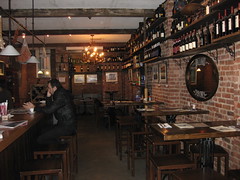When many of us hear “Palermo,” we think “Mafia,” or possibly “the guy who cuts my hair.” To Giusto Priola, Palermo, on Sicily’s northern coast, conjures up almondola, a chewy cookie made of boiled almonds, sugar and egg white, or the soft, pulpy pizza dough known as sfingione. Giusto was born in Misilmera, a little town 15 minutes outside of Palermo, and is now the master of a mini-empire of Second Ave Italian restaurants — Cacio e Pepe at 182 (between 11th and 12th); Cacio e Vino at 80 (between Fourth and Fifth); and Ballaro, across the street at 77.
Giusto is a warm-blooded fellow with close-cropped black hair on a rather round head. He left Italy 14 years ago to work for a friend in the commissary of the Pier 59 studio, where he made pastry for photographers and models. In 2004, he opened Cacio e Pepe, a Roman-style restaurant where the signature dish, a simple and traditional Roman pasta, is served in a hollow carved into a giant block of pecorino. He began to slip a few Sicilian specialties into the menu, like tuna with agua dolce. Giusto says that his customers asked him where he was from. When he told them, they said he had to open up a new place. “They invited me to open a Sicilian restaurant,” says Giusto with a sparkle in his eye. “This was my dream.” Thus was born Cacio e Vino, which serves classic Sicilian dishes like arancina —rice balls mixed with ground beef, peas, ham and bechamel — as well as pizza and schiacciate, a kind of stuffed pizza.
Because the Cacio restaurants are open only at dinner, I am a regular only at Ballaro, a prosciutteria which serves Italian meats and cheeses, and now that Giusto has installed an oven, a small selection of baked pastas. There is, it’s true, nothing Sicilian about the fennel-seed salami known as finocchiona, or the pecorino or taleggio; they’re eaten all over Italy. But the name itself is an act of homesick conjuring, for Ballaro is a thousand-year-old food market in Palermo. And Giusto is slowly Sicilianizing the menu, as he did at Cacio e Pepe. He now serves annelletti, a Sicilian ring-shaped pasta with ground beef, peas and eggplant, as well as the aforementioned almondola and other Sicilian sweets. Giusto, who is a pastry chef by trade, points out that most of the Italian sweets we know, including cannoli, are of Sicilian origin.
 Richard G. Jones The interior of Ballaro, which is named for a thousand-year-old food market in Sicily.
Richard G. Jones The interior of Ballaro, which is named for a thousand-year-old food market in Sicily.There are two overwhelming reasons to eat in Italian restaurants. One is that Italians put such store by pure, seasonal ingredients and simple preparation. The other is that Italians create happy places. Ballaro, where the brick walls are lined with bottles of wine and olive oil and cans of tomato sauce, is such a place. On my first visit, inside of 15 minutes I had met Giusto and Alessandro, Cacio e Vino’s pastry chef, who was hanging around at the bar. My friend Raghida pointed to a jar on the wall and asked our waitress, Denise, what was in it. “Truffle oil,” she said. Raghida seemed oddly fascinated by this answer, and interrogated Denise extensively on the subject. When Denise brought over our meat and cheese platter, she added in caciotta al tartufo—a truffled cheese. She also filled our wine glasses to the brim.
Denise is a dark-eyed Roman with upswept honey-colored hair and very low-slung jeans. Raghida, who can be imperious, summoned her over and said, “Please explain to me how you can walk with your pants like that.” Actually, Denise admitted, at times the force of gravity defeated even her practiced gait. And then she sashayed across the room in splay-footed Chaplinesque style. That’s how.
Denise works Wednesday and Thursday. Giusto can usually be found at his beloved Cacio e Vino, but often drops by Ballaro. There’s more Sicilianizing to do. Giusto is planning to make sfingione pizza, with onions and anchovies and caciocavallo cheese, when a new oven arrives at Ballaro. Perhaps he’ll bring in some pistachios from Bronte, near Catania, for cookies. He has so much more to teach us about Sicily.
Ballaro, 77 Second Avenue, 212-228-2969.www.ballaronyc.com




